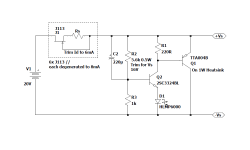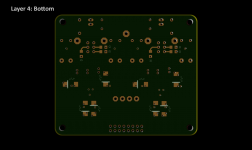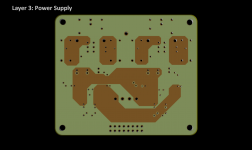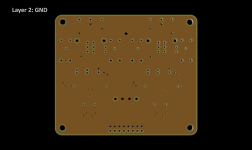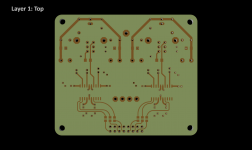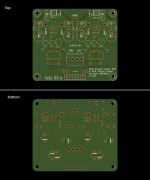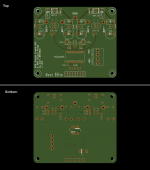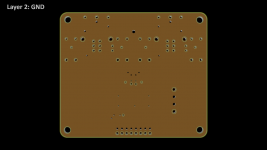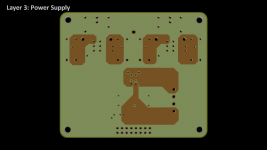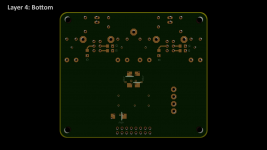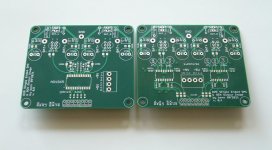Darlington : exactly the same as yours . Resistor value and pot ? No idea here. I assume the first resistor is to bias the base, so why not the same as your shematic ? Can't help more.
the pot and the gnd resitor are just to adjust the voltage of the TL431, you can had a resistor as well between the pot and the tL431 kathode, but you needn't. Sims are not my cup of tea. But I have a reg like that and it sounds very good on a subjective point of view. Should work fine with your LM idea and the good filtering you showed before for you analog stage. Cheap to try.
the pot and the gnd resitor are just to adjust the voltage of the TL431, you can had a resistor as well between the pot and the tL431 kathode, but you needn't. Sims are not my cup of tea. But I have a reg like that and it sounds very good on a subjective point of view. Should work fine with your LM idea and the good filtering you showed before for you analog stage. Cheap to try.
Last edited:
yep your shematic is what I meant. But there is no negative, it's a ground instead the minus in your shematic: i.e you need the opposite on the other side and adapt active parts for the negative rail. Share the Gnd (minus on your shematic), what you probably did at seing your verroboard. So a classic + Gnd - : as on your verroboard
Last edited:
There is no + Gnd - in the power supply for SEN IV or CEN IV.
Just a single floating supply that swings with the output.
His vero board contains 2 channels of floating supply for SEN.
And if anything I would seprate them more physically to avoid cross coupling.
Cheers,
Patrick
Just a single floating supply that swings with the output.
His vero board contains 2 channels of floating supply for SEN.
And if anything I would seprate them more physically to avoid cross coupling.
Cheers,
Patrick
Patrick,
thanks for this. I will gather the parts now next and will report back how I get on. I have a few improvements to make to the supply as per post 2212 and then will test against this one. I also want to test using just your/Gerhard regulator after batteries as well.
Lots to do!!
thanks for this. I will gather the parts now next and will report back how I get on. I have a few improvements to make to the supply as per post 2212 and then will test against this one. I also want to test using just your/Gerhard regulator after batteries as well.
Lots to do!!
Custom Sen PCBs for Oppo 105d
Indulge me for a moment, but I want to share my small project.
Following on from my posts 2010, the custom PCBs, arrived, got loaded, and installed.
These don't move the goalposts and are based on EUVL's and NIC's base designs.
With respect to EUVL and everyone else, these are customized SEN and Charging board for the Oppo 105d player. They came out quite well I think and sound ok so far.
At some point, the Batteries and wires will be further tidied, but good for now
cheers
Indulge me for a moment, but I want to share my small project.
Following on from my posts 2010, the custom PCBs, arrived, got loaded, and installed.
These don't move the goalposts and are based on EUVL's and NIC's base designs.
With respect to EUVL and everyone else, these are customized SEN and Charging board for the Oppo 105d player. They came out quite well I think and sound ok so far.
At some point, the Batteries and wires will be further tidied, but good for now
cheers
Attachments
-
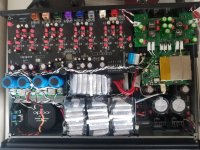 Overall install.jpg992.4 KB · Views: 439
Overall install.jpg992.4 KB · Views: 439 -
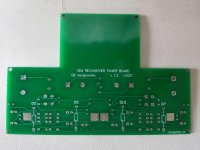 SM_Bare-Charging-Board.jpg806.5 KB · Views: 419
SM_Bare-Charging-Board.jpg806.5 KB · Views: 419 -
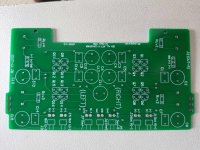 SM_Bare-SEN.jpg977.3 KB · Views: 408
SM_Bare-SEN.jpg977.3 KB · Views: 408 -
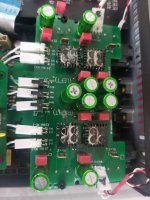 SM_Installed-SEN.jpg435.1 KB · Views: 234
SM_Installed-SEN.jpg435.1 KB · Views: 234 -
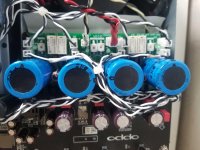 SM_Installed-Charging-Board.jpg816 KB · Views: 398
SM_Installed-Charging-Board.jpg816 KB · Views: 398 -
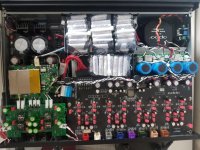 SM_Overall-install.jpg994.2 KB · Views: 225
SM_Overall-install.jpg994.2 KB · Views: 225 -
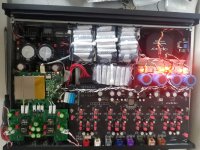 SM_Charging.jpg991.9 KB · Views: 204
SM_Charging.jpg991.9 KB · Views: 204 -
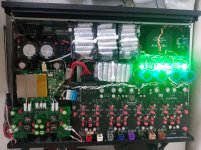 SM_Playing.jpg1,006.8 KB · Views: 224
SM_Playing.jpg1,006.8 KB · Views: 224
Last edited:
@PhopsonNY nice design!
I also recently decided to build a new dac for myself based on 2xPCM1704 and SEN (2SK146) output stage. I'm experimenting the last with four-layer PCBs. This is my second four-layer PCB. I just sent it to production. I wonder what will come of this. Prototype sounds promising. For SEN power supply I use 8xLifepo battery per channel (aprox. 26V)
Prototype sounds promising. For SEN power supply I use 8xLifepo battery per channel (aprox. 26V)
I also recently decided to build a new dac for myself based on 2xPCM1704 and SEN (2SK146) output stage. I'm experimenting the last with four-layer PCBs. This is my second four-layer PCB. I just sent it to production. I wonder what will come of this.
Attachments
Bern that looks quite sophisticated and I look forward to your report.
The layout looks efficient.
This is the first printed PCB that I have made and I am sure I made a few mistakes. For example, I see your work is perfectly symmetrical and I wonder if that is crucial to stereo fidelity.
The layout looks efficient.
This is the first printed PCB that I have made and I am sure I made a few mistakes. For example, I see your work is perfectly symmetrical and I wonder if that is crucial to stereo fidelity.
Fantastic results.
After final adjustments, the Sen sounds very good.
Corrected a reversed cable on the balanced output and now, the instruments are so precisely placed in 3d space in a way that was not evident before.
Spent too much time listening to the system yesterday as a result.
Thanks for the project EUVL.
After final adjustments, the Sen sounds very good.
Corrected a reversed cable on the balanced output and now, the instruments are so precisely placed in 3d space in a way that was not evident before.
Spent too much time listening to the system yesterday as a result.
Thanks for the project EUVL.
Fran,
did you try Salas shunt regulator with SEN
did you try Salas shunt regulator with SEN
Today I built up this same supply that @elviukai mentions in his post to see can I operate SEN without using batteries. Its partly curiosity, wondering would a different power supply have a different effect on sound, and party thinking that its easier to house a "normal" mains power supply that turns out with the rest of the unit.
So the parts arrived from Reichelt and I got to work. You'll see from the photo its just made on perfboard and I had a little trouble shooting to do on the first to get it working (I had the pinout for BD140 incorrect - watch out for this, if you google BD140 pinout the first image up has the collector labelled as emitter, had me scratching my head for a while). Building the second one then was just a matter of copying the first.
I want to say that its a little more dynamic than using the batteries (Lidl branded drill Li-ion packs) but I don't know that I can reliably tell the difference. It will take longer listening to see a more mature opinion on it. My implementation is not perfect either - the supply should be in a separate box well away from the DAC and SEN and it is not. However, there is only faint noise with the amps turned up to crazy high levels, way beyond very loud listening levels. So not as quiet as batteries, but less than the noise floor of most amps I think.
So why am I even posting this - well, from reading the thread, very few people have built this power supply, and using a power supply vs batteries pops up again and again. So its just to confirm that this supply will work with SEN. Watch that BD140 pinout and don't make my silly mistake!!
Fran
In a word, no.
I had built the Joachim Gerhard one, and while the EUVL one offers better performance, I still had some residual noise from the supply that I thought wouldn't be resolved by the changes. On the other hand, I felt the sound was better than the Li-ion batteries I was using. So I sent it to a friend of mine who had a few packs of LiFePO4 batteries. He ran it from the Gerhard supply and the LiFePO4 packs and found no difference in sound - except that the stage was completely silent with the batteries.
So since then I have gone that route, series connecting 5 batteries per channel to give me around 16-17V floating and the sound is very good. The battery packs should last a very long time, so I put a note on them to remind myself to check them in a month or so. I reckon the current draw is low enough for the packs to last a lot longer than that.
So after a lot of experimentation, I am back to batteries, and to what I think is the king of them, the LiFePO4 type.
I had built the Joachim Gerhard one, and while the EUVL one offers better performance, I still had some residual noise from the supply that I thought wouldn't be resolved by the changes. On the other hand, I felt the sound was better than the Li-ion batteries I was using. So I sent it to a friend of mine who had a few packs of LiFePO4 batteries. He ran it from the Gerhard supply and the LiFePO4 packs and found no difference in sound - except that the stage was completely silent with the batteries.
So since then I have gone that route, series connecting 5 batteries per channel to give me around 16-17V floating and the sound is very good. The battery packs should last a very long time, so I put a note on them to remind myself to check them in a month or so. I reckon the current draw is low enough for the packs to last a lot longer than that.
So after a lot of experimentation, I am back to batteries, and to what I think is the king of them, the LiFePO4 type.
In a word, no.
I had built the Joachim Gerhard one, and while the EUVL one offers better performance, I still had some residual noise from the supply that I thought wouldn't be resolved by the changes. On the other hand, I felt the sound was better than the Li-ion batteries I was using. So I sent it to a friend of mine who had a few packs of LiFePO4 batteries. He ran it from the Gerhard supply and the LiFePO4 packs and found no difference in sound - except that the stage was completely silent with the batteries.
So since then I have gone that route, series connecting 5 batteries per channel to give me around 16-17V floating and the sound is very good. The battery packs should last a very long time, so I put a note on them to remind myself to check them in a month or so. I reckon the current draw is low enough for the packs to last a lot longer than that.
So after a lot of experimentation, I am back to batteries, and to what I think is the king of them, the LiFePO4 type.
Thanks, Good report.
Have you experimented with more LiFePO4 batteries connected in series? (e.g. 6s-8s)
As Patrick wrote:
But at the same time, as you connect more batteries in series, the battery internal impedance increases (as well as jfets' heat dissipation).The higher the voltage, the lower the capacitances, the lower the distortion.
I wonder if there is any optimum in the amount of LiFePO4 (for example ANR26650M1-B) batteries connected in series for SEN?
Last edited:
Personally, I haven't experimented with this - it was down to how many cells I had to hand! I know i have a vague memory of someone else using 6 or 7 in series but maybe that was for something else. Also, I have a different use for this same battery pack, so it suited me to have a voltage around 16-18v.
On a completely different project, I have use 2 banks of 10 of these batteries and it worked very well.
On a completely different project, I have use 2 banks of 10 of these batteries and it worked very well.
Recently, I found an AD1865 chip in my DIYaudio junk. That's why I decided to make a new PCB with this chip (together with SEN and 2SK146BL) and add it to the DACs collection.
PCB based on 2xPCM1704 I already ordered 2 weeks ago.
The new AD1865 board has the same dimensions as the previous one (2xPCM1704), the same power supply, the same connectors/headers. I hope to be able to listen to both good old R2R DACs with SEN and switch easily between them depending on my preferences.
In some time (rather distant because unfortunately I have limited time for the DIYAudio hobby) we will see/hear what will come of it.
PCB based on 2xPCM1704 I already ordered 2 weeks ago.
The new AD1865 board has the same dimensions as the previous one (2xPCM1704), the same power supply, the same connectors/headers. I hope to be able to listen to both good old R2R DACs with SEN and switch easily between them depending on my preferences.
In some time (rather distant because unfortunately I have limited time for the DIYAudio hobby) we will see/hear what will come of it.
Attachments
Last edited:
@PhopsonNY nice design!
I also recently decided to build a new dac for myself based on 2xPCM1704 and SEN (2SK146) output stage. I'm experimenting the last with four-layer PCBs. This is my second four-layer PCB. I just sent it to production. I wonder what will come of this.Prototype sounds promising. For SEN power supply I use 8xLifepo battery per channel (aprox. 26V)
On your PCB I see only one 2SK146 per channel. I would have expected a second one or a pair of ... Do I understand something wrong about SEN?
On your PCB I see only one 2SK146 per channel. I would have expected a second one or a pair of ... Do I understand something wrong about SEN?
1piece of 2SK146 (which is double N-channel jfet) is the equivalent of two pieces of 2SK369 and the equivalent of 4 pieces of 2SK170
Interesting.Thank you. Learned something again
Is 2SK146 the same as IFN146 ?
I don't know InterFET products and (IFN146 particularly) but I have little experience in electronics....
They seem to be trying to recreate the good audio parts that have disappeared from active sale.
In the data sheets they write: "The -50V InterFET IFN146 is a low noise high gain replacement for the Japanese 2SK146 JFET."
The price for one piece seems high. I wonder if these double jfets come with IDSS within 10mA and what about audio quality (compared to Toshiba).
- Home
- Source & Line
- Digital Line Level
- Zen -> Cen -> Sen, evolution of a minimalistic IV Converter
